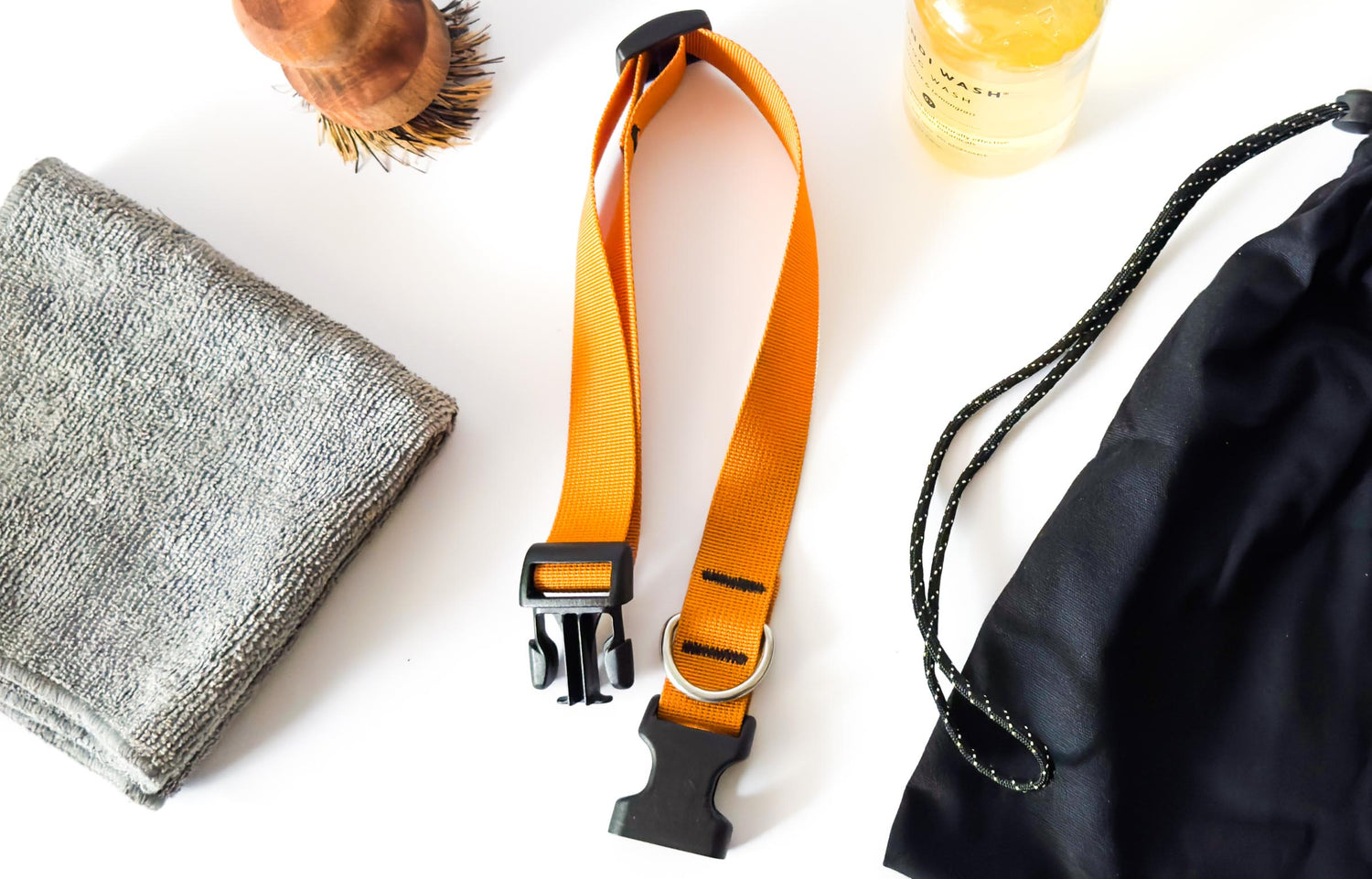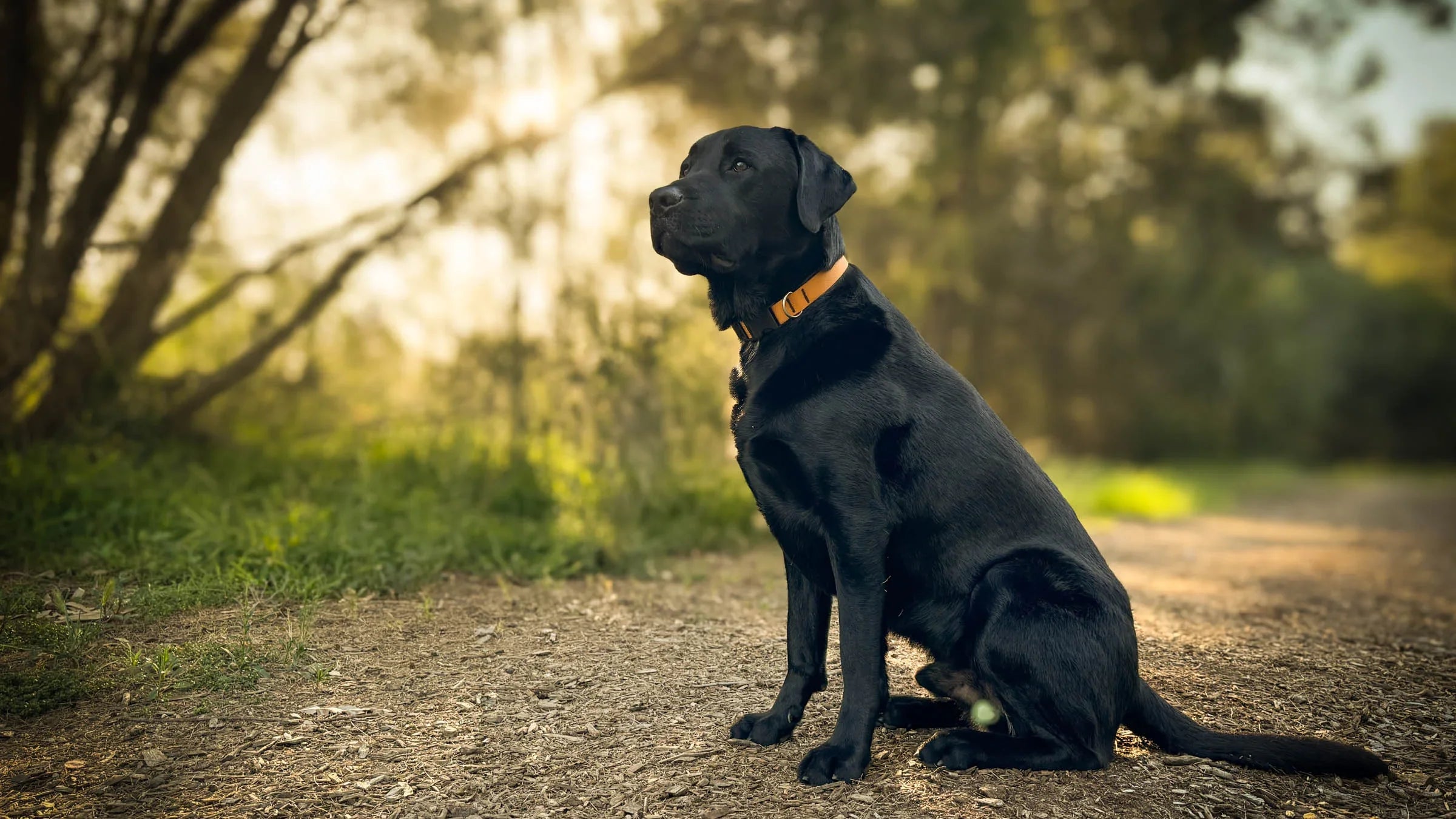Dog collars are essential for your dog's safety and style, but with regular use, collars can accumulate dirt, oils, and smells. Keeping them clean not only extends their lifespan but also ensures your dog stays comfortable. This guide walks you through how to properly clean a dog collar, helping you maintain hygiene and longevity with minimal effort.
Summary
- Wash collars every 4-6 weeks or after muddy or ocean adventures.
- Use mild dog shampoo for hand washing or a delicate cycle for machine washing.
- Air dry for long-term care, but use a dryer on low heat with a wash bag for quicker drying.
- Avoid bleach and harsh chemicals that may weaken fibres.
- Rinse collars after saltwater exposure to maximise longevity.
- All these methods can be applied to leashes and harnesses as well.
Why You Should Clean Your Dog’s Collar Regularly
Cleaning your dog’s collar isn't just about hygiene—it’s also about extending its lifespan. Dirt and oils from your dog’s skin can gradually break down the fibres in the collar over time, making regular maintenance essential. After muddy hikes or ocean adventures, it’s especially important to wash the collar thoroughly.
A simple rinse after outdoor adventures is often enough. But if you want to maintain peak performance and cleanliness, regular washing will maximise lifespan.
How to Clean a Dog Collar by Hand vs. Machine
Knowing how to clean a dog collar depends on your preferred method and the material of the collar. Hand washing is a gentle, straightforward approach. It’s perfect for day-to-day maintenance, while machine washing is great when you need a deeper clean or when the collar gets really dirty.
Hand Washing Method
- Fill a bowl with warm water and add a small amount of mild dog shampoo.
- Let the collar soak for 10-15 minutes.
- Use a soft brush to scrub away dirt and grime.
- Rinse thoroughly and hang the collar to dry.
Machine Washing Method
For nylon collars or other durable materials, machine washing can be quick and efficient. Just remember to protect both the collar and your machine.
- Place the collar in a wash bag or pillowcase.
- Wash on a cold or warm cycle using mild detergent.
- After washing, air dry or use a dryer on low heat with the collar still in the wash bag.
How Often Should You Clean Your Dog Collar?
For most dogs, a wash every 4-6 weeks is a good baseline to prevent dirt and odours from building up. If your dog frequently rolls in mud or swims in saltwater, you’ll want to wash the collar more frequently.
- Machine Washing: Using a wash bag (or pillowcase) in the washing machine provides protection for the collar’s hardware and reduces wear on the fabric by limiting direct contact with the machine’s agitator.
- Hand Washing: While hand washing allows for more targeted cleaning, scrubbing the collar manually can potentially cause wear if done too vigorously. However, for a gentle clean, hand washing is perfectly effective.
Neither method is inherently harsher if done correctly. Machine washing with a protective bag can be gentler on the collar, while hand washing allows for more control but requires care during scrubbing. Wash frequency remains 4-6 weeks as a good baseline, with adjustments based on your dog's activity level.
Is It Safe to Use a Dryer When Cleaning a Dog Collar?
Air drying is the safest way to dry a dog collar, but if you’re short on time, using a dryer can be a good alternative. The key is knowing how to use it without causing damage.
Most plastic buckles found on dog collars are made from acetal. This material is tough and heat-resistant, with a melting point over 165°C. Since a dryer’s warm cycle only reaches around 50-60°C, your collar’s buckles won’t melt. However, over time, repeated exposure to high heat could weaken the buckles. That's why it's best to use a low-heat setting.
When to Use a Dryer
- After a particularly wet or muddy adventure, when you need the collar dry fast.
- Always use a wash bag, and set the dryer to low heat.
- For routine cleaning, air drying is still preferred, as it’s gentler on the materials and hardware components.
How to Clean a Dog Collar Without Harsh Detergents
One of the most common debates in dog care is whether it’s okay to use human shampoo or standard laundry detergent when cleaning a dog collar. While you can toss collars into the wash with regular detergent, if your dog has sensitive skin, it’s better to err on the side of caution.
The Safe Option
Opt for a mild, dog-specific shampoo, which is formulated to match your dog's skin pH and prevent irritation. If you’re machine washing, choose a fragrance-free detergent that’s gentle enough for everyday use. Harsh chemicals like bleach can weaken fibres over time, even if the collar seems durable.
If you do need to spot-treat stains or odours, vinegar and baking soda can both work wonders without harming your dog or the collar.
Extra Tips for How to Clean a Dog Collar
Here are some extra ways to help your collar last longer and stay fresh.
Rinse After Ocean Adventures
Saltwater can break down even the toughest collars, so always rinse your dog’s collar in fresh water after a trip to the beach. This prevents the salt from causing long-term damage to the fibres and hardware components.
Wash the Collar When You Bathe Your Dog
This probably sounds obvious but is often overlooked. Washing your dog collar by hand whenever you bathe your dog means you’re not putting a dirty collar back on a freshly cleaned dog. Use the same dog shampoo you’re already using for the bath, and scrub the collar gently before rinsing it thoroughly and hanging it up to dry. This ensures your dog’s collar stays as fresh as they are.
Deodorise with Vinegar
If your dog’s collar has absorbed strong odours, vinegar can help. A mixture of vinegar and water works well to neutralise smells. Let the collar soak in the solution for 10-15 minutes before giving it a thorough rinse.
Common Mistakes to Avoid When Cleaning a Dog Collar
Learning how to clean a dog collar properly means knowing what to avoid, too. Here are some common cleaning mistakes and how to sidestep them.
Avoid High Heat
Plastic buckles are sturdy, but they can still weaken if exposed to high dryer heat repeatedly. Always use a low-heat setting and a wash bag to protect the collar.
Direct Sunlight
Standard nylon or other soft collars may fade when exposed to direct sunlight for long periods. To keep colours bright, hang your dog collar to dry in a shaded area.
Steer Clear of Harsh Chemicals
Bleach and other strong detergents can weaken even durable fibres over time. Stick to mild cleaning solutions that are safe for both your dog and the collar.
Conclusion
Knowing how to clean a dog collar properly is the key to making sure it lasts as long as possible. Whether you prefer hand washing or machine washing, regular cleaning keeps your dog’s collar fresh and functional. Remember to avoid high heat, rinse after salty or muddy adventures, and use dog-friendly shampoos to prevent damage. With these tips, your dog’s collar will look great and perform well for many adventures to come.




Leave a comment
This site is protected by hCaptcha and the hCaptcha Privacy Policy and Terms of Service apply.